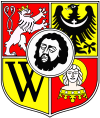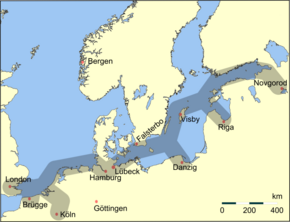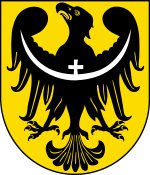Wrocław
| Wrocław | |||
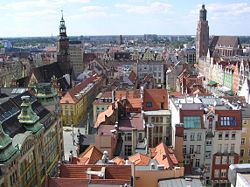 |
|||
|
|||
| Motto: Miasto spotkań / Meeting Place | |||
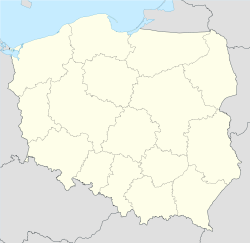 Wrocław
|
|||
| Coordinates: | |||
| Country | |||
|---|---|---|---|
| Voivodeship | Lower Silesian | ||
| County | city county | ||
| Established | Tenth century | ||
| City rights | 1262 | ||
| Government | |||
| - Mayor | Rafał Dutkiewicz | ||
| Area | |||
| - City | 292.82 km² (113.1 sq mi) | ||
| Elevation | 111 m (364 ft) | ||
| Population (2007) | |||
| - City | 689,280 | ||
| - Density | 2,353.9/km² (6,096.7/sq mi) | ||
| - Metro | 1,030,000 | ||
| Time zone | CET (UTC+1) | ||
| - Summer (DST) | CEST (UTC+2) | ||
| Postal code | 50-041 to 54-612 | ||
| Area code(s) | +48 71 | ||
| Car plates | DW | ||
| Website: http://www.wroclaw.pl | |||

Wrocław [ˈvrɔt͡swaf] (![]() listen) (German: Breslau (
listen) (German: Breslau (![]() listen); Czech: Vratislav; Latin: Vratislavia or Wratislavia; Yiddish: ברעסלוי) is the chief city of the historical region of Lower Silesia in south-western Poland, situated on the Oder (Polish: Odra) river. Over the centuries the city has been part of Poland, Bohemia, Austria, Prussia, and Germany. In 1945, the city became part of Poland once more following the Potsdam Agreement. Since 1999 it has been the capital of Lower Silesian Voivodeship. According to official population figures for 2006, its population is 635,280, making it the fourth largest city in Poland.
listen); Czech: Vratislav; Latin: Vratislavia or Wratislavia; Yiddish: ברעסלוי) is the chief city of the historical region of Lower Silesia in south-western Poland, situated on the Oder (Polish: Odra) river. Over the centuries the city has been part of Poland, Bohemia, Austria, Prussia, and Germany. In 1945, the city became part of Poland once more following the Potsdam Agreement. Since 1999 it has been the capital of Lower Silesian Voivodeship. According to official population figures for 2006, its population is 635,280, making it the fourth largest city in Poland.
Contents |
Etymology
The city's name was first recorded in the year 1000 by Thietmar's Latin chronicle called Thietmari Merseburgensis episcopi Chronicon as Wrotizlawa. The first municipal seal stated Sigillum civitatis Wratislavie. Simplified name is given in 1175 as Wrezlaw, Prezla or Breslaw. The Czech spelling was used in Latin documents as Wratislavia or Vratislavia. At that time, Prezla was used in Middle High German, which became Preßlau. In the middle of the fourteenth century the Early New High German (and later New High German) form of the name Breslau began to replace its earlier versions.
The city is traditionally believed to be named after Wrocisław or Vratislav, often believed to be Duke Vratislaus I of Bohemia. It is also possible that the city was named after the tribal duke of the Silesians or after an early ruler of the city called Vratislav.
The city's name in various foreign languages include in English: Wroclaw, Hungarian: Boroszló, Italian: Breslavia, Latin: Vratislavia or Wratislavia, Hebrew: ורוצלב (Vrotsláv), Slovak: Vratislav or Vroclav, Belarusian: Уроцлаў (Vrotslai), Greek: Βρότσλαβ (Vrotslav), Russian: Вроцлав (Vrotslav); also Бреславль (Breslavl), Serbian: Вроцлав or Vroclav and Ukrainian: Вроцлав (Vrotslav). Names of Wrocław in other languages are also available. .
History

The city of Wrocław originated in Lower Silesia as a Bohemian stronghold at the intersection of two trade routes, the Via Regia and the Amber Road. The city was first recorded in the tenth century as Vratislavia, possibly derived from the name of a Bohemian duke Vratislav I. Its initial extent was limited to district of Ostrów Tumski (the Cathedral Island).
| Centennial Hall in Wrocław* | |
|---|---|
| UNESCO World Heritage Site | |
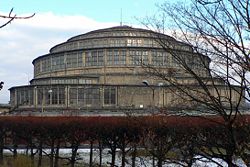 |
|
| State Party | |
| Type | Cultural |
| Criteria | i, ii, iv |
| Reference | 1165 |
| Region** | Europe and North America |
| Inscription history | |
| Inscription | 2006 (30th Session) |
| * Name as inscribed on World Heritage List. ** Region as classified by UNESCO. |
|
Middle Ages
During Wrocław's early history, its control changed hands between Bohemia (till 992 and then 1038-1050), the Kingdom of Poland (992-1138), and an (Piast) duchy of Silesia - part of the divided Kingdom of Poland. In the first half of the thirteenth century Wrocław even became the center of the divided state.[1]
The city became a commercial center and expanded to Wyspa Piaskowa (Sand Island), then to the left bank of the Oder River. Around 1000 the town had 1000 inhabitants[2]. By 1139 a settlement belonging to Governor Piotr Włostowic (a.k.a Piotr Włast Dunin) was built, and another was founded on the left bank of the Oder River, near the present seat of the university. While the city was Polish, there were also communities of Bohemians, Jews, Walloons[3]and Germans[4].
The city was devastated in 1241 during the Mongol invasion of Europe. The inhabitants burned the city to force the Mongols to a quick withdrawal.
The population was replenished by Germans[5] who settled there and became the dominant ethnic group, though the city remained multi-ethnic[6]. Breslau, the Germanised name of the city, appeared for the first time in written records, and the city council used only Latin and German from the beginning.[5]
Breslau was expanded by adopting a German town law. The expanded town was around 60 hectares and the new Main Market Square (Rynek), which was covered with timber framed houses, became the new center of the town. The original foundation, Ostrów Tumski, became the religious center. Breslau adopted Magdeburg rights in 1262 and, at the end of the thirteenth century joined the Hanseatic League. The Polish Piast dynasty[7] remained in control of the region, but the city council's right to govern independently increased.

In 1335, Breslau was incorporated with almost all of Silesia into the Kingdom of Bohemia, then a part of Austria. Between 1342 and 1344, two fires destroyed large parts of the city.
Renaissance, Reformation and Counter-Reformation
The Protestant Reformation reached Breslau in 1518 and the city became Protestant. Breslau supported the Bohemian revolt in fear of losing the right to freedom of religious expression. In the following Thirty Years' War the city was occupied by Saxon and Swedish troops and lost 18,000 of 40,000 citizens to plague.
The Austrian emperor brought in the Counter-Reformation by encouraging Catholic orders to settle in Breslau, starting in 1610 with the Minorites, followed by Jesuits, Capucins, Franciscans, and finally Ursulines in 1687. These orders erected buildings which shaped the Breslau's appearance until 1945. At the end of the Thirty Years' War, however, Breslau was one of only a few Silesian cities to stay Protestant.
During the Counter-Reformation, the intellectual life of the city, shaped by Protestantism and Humanism, flourished, even as the Protestant bourgeoisie lost its role as the patron of the arts to the Catholic orders. Breslau became the center of German Baroque literature and was home to the First and Second Silesian school of poets.

The age of Enlightment
The Kingdom of Prussia annexed Breslau and most of Silesia during the War of the Austrian Succession in the 1740s. Habsburg empress Maria Theresa renounced the territory in 1763.
Before and after World War I
During the Napoleonic Wars, Breslau was occupied by an army of the Confederation of the Rhine. The fortifications of the city were leveled and monasteries and cloisters were secularized. The Protestant Viadrina university of Frankfurt (Oder) was relocated to Breslau in 1811, and united with the local Jesuit University to create the new Schlesische Friedrich-Wilhelm-Universität (Silesian Frederick-William University), now (Wrocław University). The city became the center of the Liberation movement against Napoleon; volunteers from all over Germany gathered there.
Prussian reforms increased prosperity in Silesia and Breslau. The leveled fortifications opened space for Breslau to grow beyond its old limits. Breslau became an important railway hub and industrial centre, notably of linen and cotton manufacture and metal industry. The unified university resulted in the city becoming a major Prussian center of sciences, and the secularization laid the base for a rich museum landscape.
German unification in 1871 made Breslau the sixth-largest city in the German Empire. Its population more than tripled to over half a million between 1860 and 1910. The 1905 census lists 470,904 residents, including 440,596 Germans, 20,536 Jews, 6,020 Poles and 3,752 others.
Important landmarks were inaugurated in 1910, the Kaiserbrücke (Kaiser bridge) and the Technische Hochschule (TH), which now houses the Wrocław University of Technology. In 1913 the newly-built Centennial Hall housed the "Ausstellung zur Jahrhundertfeier der Freiheitskriege", an exhipition commemorating the 100th anniversary of the historical German Wars of Liberation against Napoleon and the first award of the Iron Cross.
In 1919, Breslau became the capital of the newly created Province of Lower Silesia. During August 1920 at the time of Polish Silesian Uprising in neighbouring Upper Silesia, The Polish consulate and school were demolished while the Polish Library was burned down by a mob. The number of Poles in Breslau dropped from 2 percent before World War I to 0.5 percent after the reconstitution of Poland[8]. Antisemitic riots occurred in 1923[9].
The city boundaries were expanded between 1925 and 1930 to include an area of 175 km² with a population of 600.000. In 1929 the Werkbund opened WuWa (German: Wohnungs- und Werkraumausstellung) in Breslau-Scheitnig, a international showcase of modern architecture by architects of the Silesian branch of the Werkbund. In June 1930 Breslau hosted the Deutsche Kampfspiele, a sporting event for German athletes after Germany was excluded from the Olympic Games after World War I.
The city became one of the largest support bases of Nazis, who in the 1932 elections received 43,5 % of Breslau's votes, their third largest total in the entire country[10].
After Hitler's takeover of the German government in 1933, political enemies of the Nazis like Communists, Social Democrats, trade unionists, Jews, Poles and Homosexuals were persecuted, their institutions closed or destroyed.[11][12][13] Many of the city's 10,000 Jews as well as many other political enemies were sent to concentration camps; those Jews who remained were killed during the Holocaust. [14]. A network of concentration camps and forced labour camps was established around Breslau, to serve industrial concerns, including FAMO, Junkers and Krupp. Tens of thousands were imprisoned there.[1]
The Deutsches Turn- und Sportfest (German Gym and Sports Celebration), the last big event organized by the Nazi Sports Body, took place in Breslau from 26 to 31 July 1938. The Sportsfest was held in Breslau to commemorate the 125th anniversary of the German Wars of Liberation against Napoleon's invasion.[15]
World War II and afterwards
For most of World War II the fighting was not close to Breslau. As the war lengthened, refugees from bombed-out German cities, and later refugees from farther east, swelled the population to nearly one million[16].
In February 1945 the Soviet Red Army approached the city. Gauleiter Karl Hanke declared the city a Festung (fortress) to be held at all costs. Hanke finally lifted a ban on the evacuation of women and children when it was almost too late. During his poorly organised evacuation in early March 1945, 18,000 people froze to death in icy snowstorms and -20°C weather. By the end of the Siege of Breslau, half the city had been destroyed. Am estimated 40,000 civilians lay dead in the ruins of homes and factories. After a siege of nearly three months, "Fortress Breslau" surrendered on 7 May 1945, just before the end of the war.[17]
After World War II Wrocław became part of Poland under the terms of the Potsdam Conference. Most remaining German inhabitants fled or were expelled. The population of Wrocław was increased by resettlement of Poles.
Wrocław is now a European city with a Polish population and a mixed architectural heritage, influenced by Bohemian, Austrian, Prussian and German traditions, as well as a number of buildings by eminent German modernist architects.
In July 1997, the city was heavily affected by a flood of the Oder River, the worst flooding in post-war Poland, Germany, and the Czech Republic. Around one third of the city's area stood under water.[18] An earlier equally devastating flood of the river took place in 1903.[19]
Climate
Wrocław is one of the warmest cities in Poland. Lying in the Lower-Silesian region, one of the warmest in Poland, the mean annual temperature is 8.5 °C.
| Month | Jan | Feb | Mar | Apr | May | Jun | Jul | Aug | Sep | Oct | Nov | Dec | Year |
|---|---|---|---|---|---|---|---|---|---|---|---|---|---|
| Average high °C (°F) | 2 (34) |
3 (37) |
8 (46) |
13 (56) |
18 (65) |
27 (81) |
29 (84) |
28 (83) |
24 (76) |
14 (57) |
7 (45) |
3 (37) |
13 (55) |
| Average low °C (°F) | -6 (22) |
-4 (24) |
-1 (30) |
5 (41) |
12 (54) |
16 (61) |
17 (63) |
17 (62) |
8 (47) |
5 (40) |
1 (33) |
-3 (26) |
5 (40) |
| Precipitation cm (inches) | 2.8 (1) |
2.6 (1) |
3 (1) |
3.8 (1.1) |
5 (2) |
6.6 (2.1) |
7.6 (2.4) |
7.1 (2.2) |
4.6 (1.5) |
4 (1.3) |
3.8 (1.3) |
3.6 (1.2) |
54.9 (20.3) |
| Source: Weatherbase[20] 2008-07-30 | |||||||||||||
Administration






Wrocław is the capital city of Lower Silesian Voivodeship, a province (voivodeship) created in 1999. It was previously the seat of Wrocław Voivodeship. The city is a separate urban gmina and city county (powiat). It is also the seat of Wrocław County, which adjoins but does not include the city.

Source: http://www.breslau-wroclaw.de.
Wrocław is subdivided into five boroughs (dzielnicas):
- Fabryczna ("Factory Quarter")
- Krzyki ("Shouts"), (German: Krietern)
- Psie Pole (German: Hundsfeld, "Dogs' Field", named so after the Battle of Hundsfeld)
- Stare Miasto (Old Town)
- Śródmieście (City Centre)
Main sights
- Rynek (market square) with the fourteenth century Town Hall
- Hala Ludowa ("Peoples' Hall", originally German: Jahrhunderthalle, "Centennial Hall") by Max Berg – a World Heritage Site
- Ostrów Tumski ("Cathedral Island", German: Dominsel) with Wrocław Cathedral
- Panorama Racławicka ("Racławice Panorama")
- Plac Grunwaldzki ("Grunwald Square", named for the Battle of Grunwald)
- Kościół Św. Elżbiety ("St. Elisabeth's Church")
- Wrocław Palace
Education
Wrocław is third largest educational centre of Poland with 135.000 students on 30 high schools which employ some 7.400 of staff [21].
List of ten state-owned (public) high schools:
- Wrocław University (Uniwersytet Wrocławski) - over 47,000 students, ranked forth among public universities in Poland by "Wprost" weekly ranking in 2007 [22]
- Wrocław University of Technology (Politechnika Wrocławska) - over 40,000 students, the best university of technology in Poland by "Wprost" weekly ranking in 2007 [23]
- Wrocław Medical University (Wrocławska Akademia Medyczna)
- University School of Physical Education. (Akademia Wychowania Fizycznego),
- Wrocław University of Economics (Uniwersytet Ekonomiczny we Wrocławiu) - over 18,000 students, ranked fifth best among public economic high schools in Poland by "Wprost" weekly ranking in 2007 [24]
- Wroclaw University of Environmental and Life Sciences (Uniwersytet Przyrodniczy we Wrocławiu) - over 13,000 students, ranked third best among public agricultural high schools in Poland by "Wprost" weekly ranking in 2007 [25]
- Academy of Fine Arts in Wrocław (Akademia Sztuk Pięknych we Wrocławiu)
- The Karol Lipiński University of Music (Akademia Muzyczna im. Karola Lipińskiego)
- University School of Theatre (Państwowa Wyższa Szkoła Teatralna)
- The Tadeusz Kościuszko Land Forces Military Academy (Wyższa Szkoła Oficerska Wojsk Lądowych)
Historic institutions
- Jewish Theological Seminary of Breslau
Economy
Wrocław's major industries were traditionally the manufacture of railroad cars and electronics. In recent years the City Council runs active policy to attract foreign investors from high-tech sector. This resulted among others in location of LG Electronics production cluster in Kobierzyce near Wrocław. After 1989 Wrocław became a significant financial centre and houses headquarters of several nationwide financial institutions such as Bank Zachodni WBK, Lukas Bank, Getin Bank or Europejski Fundusz Leasingowy. As of the end of 2007 Wrocław enjoyed a very low unemployment level of just 4.7% compared with the national level of 11.4% [26]
Transport
Wrocław has easy access to A4 motorway which allows for quick connection with Upper Silesia, Kraków and finally Ukraine to the east and Dresden and Berlin to the west. The city is served by Wrocław International Airport and a river port.
Major corporations
- Whirlpool Polar
- Volvo Polska sp. z o.o., Wrocław
- WABCO Polska, Wrocław
- Siemens, Wrocław
- Nokia Siemens Networks Sp z o.o
- Hewlett Packard, Wrocław
- Google, Wrocław
- Grupa Lukas, Wrocław
- AB SA, Wrocław
- Polifarb Cieszyn-Wrocław SA, Wrocław
- KOGENERACJA S.A., Wrocław
- Impel SA, Wrocław
- Europejski Fundusz Leasingowy SA, Wrocław
- Telefonia Dialog SA, Wrocław
- Tieto, Wrocław
- Wrozamet SA, Wrocław
- American Restaurants sp. z o.o., Wrocław
- Hutmen SA, Wrocław
- Fortum Wrocław S.A., Wrocław
- SAP Polska
- Hologram Industries Polska
- Zender sp. z o.o., Wrocław
- Swiftway / Eureka Solutions sp. z o.o., Wrocław
- MSI (Micro Star International) Polska Sp. z o. o.
- Cargill Poland
Religion
Like all of Poland, Wrocław's population is predominantly Roman Catholic; the city is the seat of an Archdiocese. However, post-war resettlements from Poland's ethnically and religiously more diverse former eastern territories (Polish: Kresy) and the eastern parts of post-1945 Poland (see Operation Wisła) account for a comparatively large portion of Greek Catholics and Orthodox Christians of mostly Ukrainian (see Ukrainian minority in Poland) and Lemko descent.
Professional sports
The Wrocław area has many popular professional sports teams. The most popular sport today is probably basketball, thanks to Śląsk Wrocław, the award-winning men's basketball team (former Polish champions, second-place in 2004). The group D matches of Eurobasket 2009 are scheduled to take place in Wrocław in September 2009. Some matches of the 2012 UEFA European Football Championships in Poland and Ukraine are scheduled to take place in Wrocław.
Men's sports
- Śląsk Wrocław - (previous names:BASCO Śląsk Wrocław, ASCO Śląsk Wrocław, Bergson Śląsk Wrocław, Era Śląsk Wrocław, Deichmann Śląsk Wrocław, Idea Śląsk Wrocław, Zepter Idea Śląsk Wrocław, Zepter Śląsk Wrocław, Śląsk ESKA Wrocław, Śląsk Wrocław, CWKS Wrocław) men's basketball team, 17 times Polish Champion, 6 times runner-up, 14 times third place; 12 times Polish Cup winner
- Śląsk Wrocław - men's football team (Polish Championship in Football 1977; Polish Cup winner 1976, 1987; Polish SuperCup winner 1987) (2nd league from 2005 to 2007)
- Śląsk Wrocław - men's handball team (1st league in season 2008/2009)
- Atlas volleyball team playing in Polish Volleyball League (Polska Liga Siatkówki, PLS: Seria A in 2006/2007, Seria B in 2008/2009 season).
- [2]The CREW - American Football Club - Champion of Polish American Football League 2007, First polish team played in Europen Competitions EFAF Cup in 2008.
Women's sports
- ZEC ESV Gwardia Wrocław- women's volleyball team playing in Polish Seria A Women's Volleyball League: sixth place in 2003/2004 season.
- AZS Wrocław - women's football team (1st league in season 2003/2004)
- AZS AWF Wrocław - women's handball team (1st league in season 2003/2004)
- AZS AE Wrocław - women table tennis team (1st league in season 2003/2004)
Twin towns and partnerships
Wrocław is twinned with:[27]
Twin towns:
|
Partnership:
 Vienne département. [27]
Vienne département. [27]
See also
- History of Wrocław
- List of people from Breslau
- List of people from Wrocław
- Lower Silesia (region)
- Lower Silesian Voivodeship (modern)
- Province of Lower Silesia (historic 1919 - 1945)
- Province of Silesia (historic, 1815 - 1919)
References
- ↑ (Polish) Benedykt Zientara (1997). Henryk Brodaty i jego czasy. Warsaw: Trio. pp. p:317–320. ISBN 8385660461.
- ↑ Weczerka, p. 39
- ↑ Norman Davies "Mikrokosmos" page 110-115
- ↑ Weczerka, p. 41
- ↑ 5.0 5.1 Thum, p. 316
- ↑ Norman Davies "Mikrokosmos" page 110
- ↑ Encyklopedia Powszechna PWN Warsaw 1975 vol. III page 505
- ↑ Harasimowicz, p. 466f
- ↑ Davies, Moorhouse, p. 396; van Rahden, Juden, p. 323-26
- ↑ Norman Davies "Mikrokosmos" page 369
- ↑ Davies, Moorhouse, p. 395
- ↑ Kulak, p. 252
- ↑ name="Microcosm_395"
- ↑ name="Microcosm_395"
- ↑ Breslau bonczek sportfest
- ↑ History of Wrocław
- ↑ Festung Breslau (Wrocław Fortress) siege by the Soviet Army - photo gallery
- ↑ 1997 great flood of Oder River - photo gallery
- ↑ 1903 great flood of the Oder river - photo gallery
- ↑ "Weatherbase: Historical Weather for Wrocław, Poland" (in English). Retrieved on 30 July 2008.
- ↑ Fitch Rating Report on Wrocław dated July 2008, p.3
- ↑ http://szkoly.wprost.pl/?e=49&c=5
- ↑ http://szkoly.wprost.pl/?e=49&c=6
- ↑ http://szkoly.wprost.pl/?e=49&c=8
- ↑ http://szkoly.wprost.pl/?e=49&c=9
- ↑ Fitch Rating Report for Wrocław dated July 2008, p.3
- ↑ 27.00 27.01 27.02 27.03 27.04 27.05 27.06 27.07 27.08 27.09 27.10 "Wrocław Official Website - Partnership Cities of Wrocław".



 (in English, German, French and Polish) © 2007 Wrocław Municipality. Retrieved on 2008-10-23.
(in English, German, French and Polish) © 2007 Wrocław Municipality. Retrieved on 2008-10-23. - ↑ "Ramat Gan Sister Cities". Retrieved on 2008-11-01.
Further reading
English language
- Davies, Norman; Roger Moorhouse (2002). Microcosm: Portrait of a Central European City. London: Jonathan Cape. ISBN 0224062433.
Polish language
- Długoborski, Wacław; Józef Gierowski, Karol Maleczyński (1958). Dzieje Wrocławia do roku 1807. Warszawa: PWN.
- Harasimowicz, Jan; Włodzimierz Suleja (eds.) (2001). Encyklopedia Wrocławia. Wrocław: Wydawnictwo Dolnośląskie. ISBN 83-7384-561-5.
- Maleczyński, Karol; Marian Morelowski, Anna Ptaszycka (1956). Wrocław. Rozwój urbanistyczny. Warszawa: Wydawnictwo Budownictwo i Architektura.
- Kulak, Teresa (2006). Wrocław. Przewodnik historyczny (A to Polska właśnie). Wrocław: Wydawnictwo Dolnośląskie. ISBN 8373844724.
- Świechowski, Zygmunt (ed.) (1978). Wrocław, jego dzieje i kultura. Warszawa: Arkady.
- Orzechowicz, Marian (1960). Szkice z dziejów polonii wrocławskiej. Wrocław: Zakład Narodowy imienia Ossolinskick-Wydawnictwo, 1960. ISBN 83-7384-561-5.
German language
- Scheuermann, Gerhard (1994). Das Breslau-Lexikon (2 vols.). Dülmen: Laumann Verlagsgesellschaft. ISBN 978-3899601329.
- Thum, Gregor (2003). Die fremde Stadt. Breslau 1945. Berlin: Siedler. ISBN 3-88680-795-9.
- van Rahden, Till (2000). Juden und andere Breslauer: Die Beziehungen zwischen Juden, Protestanten und Katholiken in einer deutschen Großstadt von 1860 bis 1925. Göttingen: Vandenhoeck & Ruprecht. ISBN 3-525-35732-X.
- Weczerka, Hugo (2003). Handbuch der historischen Stätten: Schlesien. Stuttgart: Alfred Kröner Verlag. ISBN 3-520-31602-1.
- Codex Diplomaticus Silesiae T.3: Henricus pauper - account book of Wroclaw, 1299-1358 (German) (Latin)
- Codex Diplomaticus Silesiae T.11 Breslauer Stadtbuch - liber civitatis (town book) of Wroclaw, containing the councilmen since 1287 and documents regarding the constitutional history (German) (Latin)
- Breslauer Urkundenbuch - complete collection of all deeds of the city (German) (Latin)
External links
- Municipal website (Polish) (English) (German) (French)
- Wroclaw Life. Travel, nightlife, photos. (English)
- Wroclaw Weekly (Polish)
- Concentration Camps in the Breslau district - 1940-1945 - by Roger Moorhouse (English)
- Virtual Wrocław (Polish)
- Wratislaviae Amici (Polish)
- Postindustrial Wroclaw (Polish)
- Wroclaw City Breaks - Tourist Information and Reviews (Polish)
- Wroclaw Strategy (Flash file: 5.4 MB) (English)
- Dobre Info.pl - all about Wroclaw. (Polish)
|
||||||||||||||||||||||||||
|
|||||||
|
||||||||||
|
|||||||

